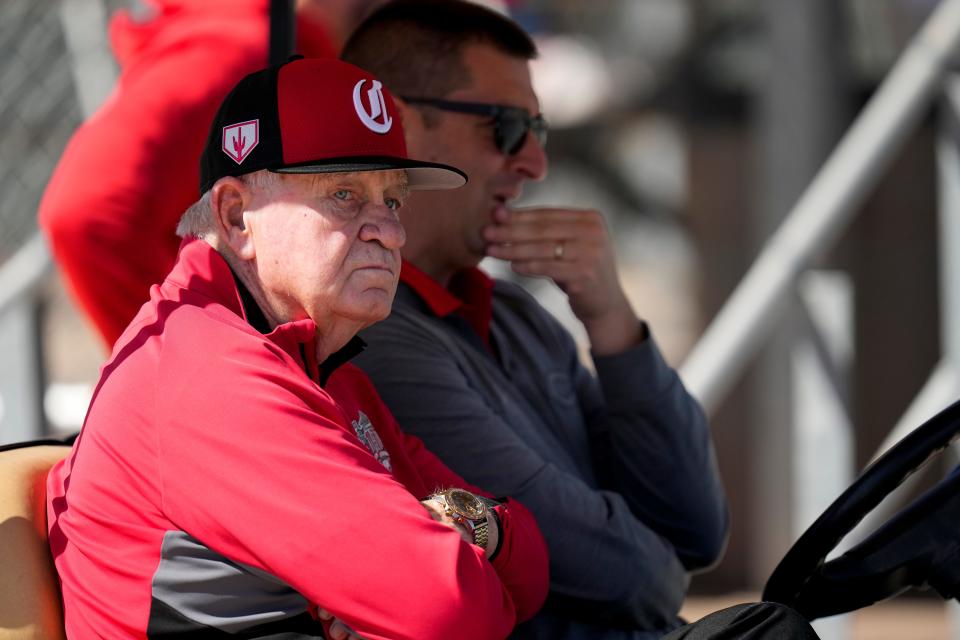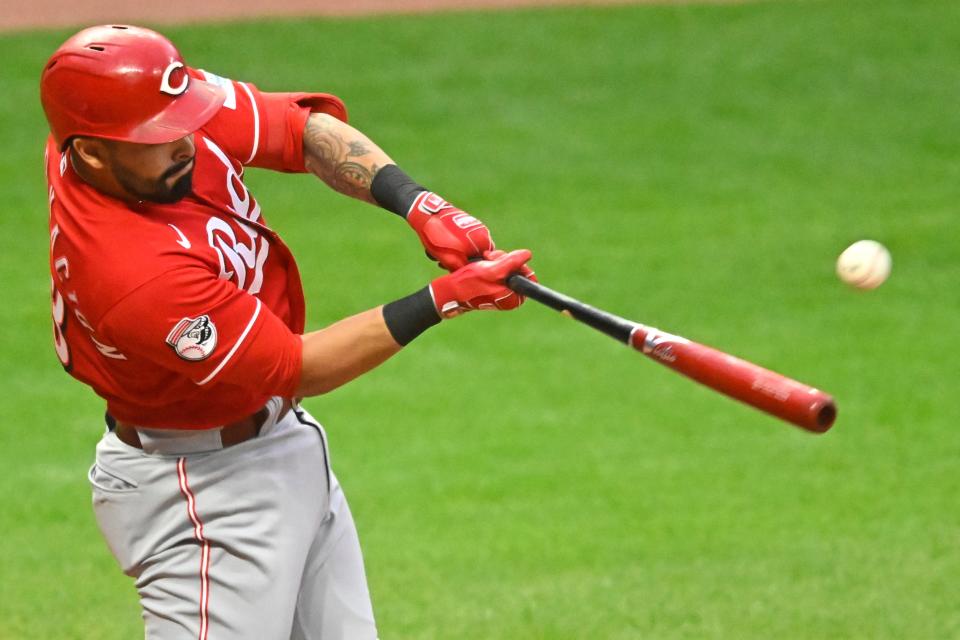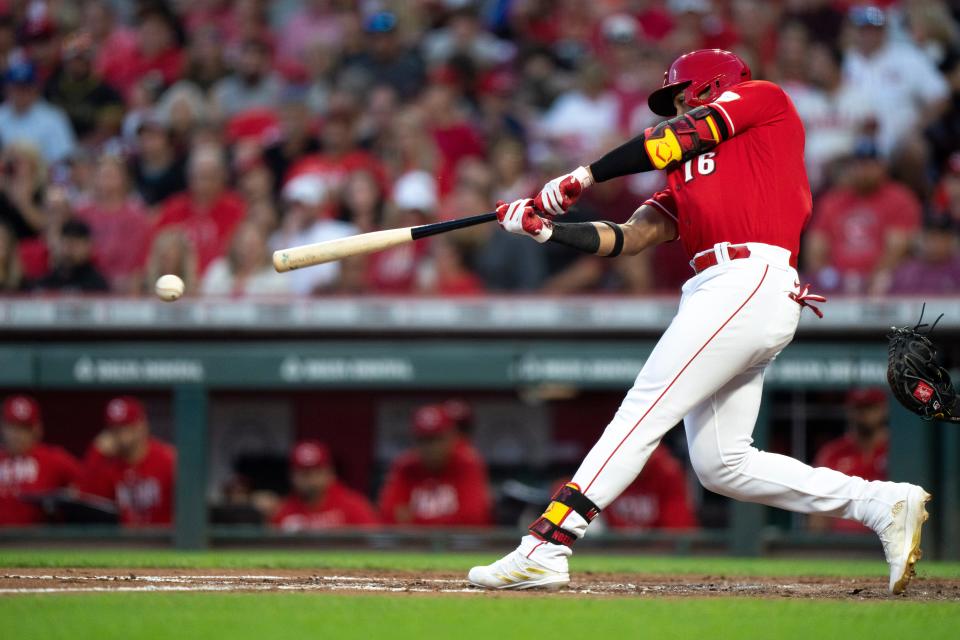Cincinnati Reds should have been Arizona Diamondbacks in '23? Not so fast, MLB execs say

SCOTTSDALE, Arizona — Just how close did the Cincinnati Reds come to being the Arizona Diamondbacks this year?
It’s a question that stirred again this past week every time somebody spotted Mike Hazen at baseball’s annual general managers meetings and congratulated the Diamondbacks’ GM on going from 110 losses to the World Series in two years flat — with one big trade-deadline deal for a closer this year along the way.
“There’s always that moment, independent of the Reds, that if you come up a little bit short, you’re beating yourself up, like, ‘Could we have done a little bit more?’ “ said Derek Falvey, the Minnesota Twins’ top baseball executive.
Reds free agency Toronto Blue Jays? Back to Cincinnati? Where MLB execs predict free agent Joey Votto lands
Reds commentary Wittenmyer & Williams: Can Reds get Sonny Gray, Aaron Nola or another top MLB starter?
Reds Elly De La Cruz Could Cincinnati Reds' Elly De La Cruz open 2024 in minors? It's not a clown question, bro
A little bit short? Like two games?
A little bit more? Like pay the painful price for a rent-a-starter?
“It’s really tough,” said Falvey, who has experience both sides of the coin. “And the interesting reality to Arizona — and I don’t want to speak on behalf of Mike — but they made those trades, and they actually struggled coming out of the (post-deadline) chute.
“The narrative of these seasons is interesting sometimes,” Falvey said. “It plays out after the fact. But if we played it all over again would it have played out that way.”
Hazen said his goal before the season started was to be a buyer at the deadline — albeit, a common goal, considering it means you’re contending — but that specifically had to do with internal evaluations of a team that made a 22-game improvement last year and had young talent in place, including the anticipation of Corbin Carroll for a full season.
“I was hoping to buy at the trade deadline and wanted to play meaningful games in August and September. We had the opportunity to do that,” Hazen said. “We had clear areas that we felt like we needed to improve.”
The Reds certainly had that — specifically, starting pitching. But they also were fresh off their own 100-loss season, with position-player holes starting to arise with injuries and slumps as the deadline approached.
And some teams wanted the Reds’ top rookie talent for some of the pitchers Reds president Nick Krall pursued — the asks including Matt McLain, Spencer Steer and Christian Encarnacion-Strand.

Krall passed. And the team with a 5.43 starting rotation ERA missed the playoffs by two games (with the tiebreaker against the Diamondbacks in hand).
“I think that every deadline there’s a view that if you make that one move, that’s the difference between whether or not you get there or don’t get there,” said Falvey, who all but stood pat this year and won a division after going all in a year ago — including the Steer/Encarnacion-Strand trade with the Reds for Tyler Mahle — and missing the playoffs.
Reds offseason moves How seller's market this winter might impact Cincinnati Reds' free agent pitching plans
Reds postseason moves Spencer Steer, Matt McLain snubbed: National League Rookie of the Year finalists announced
“A lot of whether or not you get there comes quite frankly from the group you already have. It just does,” Falvey said. “Are there pieces that will make you better? For sure.”
But also: who could predict that 84 wins would be enough to make the field? Or 86 last year for the Philadelphia Phillies?
"You can't," Seattle Mariners team president Jerry DiPoto said.
It took 89 to make it in the American League this season.
The Mariners were the team to miss that field by a game.
“For us, we’re trying to measure, like, ‘How good do we think we really are?’ “ DiPoto said. “The great juxtaposition here is our ’21 team vs. our ’22 team.”
Both were 90-win teams, but the Mariners added at the deadline in 2022 after deciding not to add in 2021 because their internal evaluations suggested they were further from contention in ’21 (they had a negative run differential).
“We weren’t one player away,” DiPoto said. “This is where I can’t speak for the Reds. I don’t know whether they thought they were one player away. But in 2022 we did think we were one player away.”
Turned out it was the same player, if, in fact, the Reds were one player away this year.
The Mariners got ace Luis Castillo (with a year-plus of club control) from the Reds at the deadline in 2022 for a haul of prospects that included pitchers Andrew Moore, Levi Stoudt and infielders Edwin Arroyo and Noelvi Marte — who might be a 2024 Rookie of the Year favorite after his impressive 2023 debut.

“It was really costly,” DiPoto said. “And it’s part of the reason why the Reds are so athletic now. But to each team, you’re trying to determine where you are on your competitive arc, and whether it’s time to push in for the one player that gets you over the edge. And we thought Luis Castillo was that player.”
Chances to make the playoffs are certainly precious, even in an era of 12-team playoff fields the past two seasons; the Reds might win 90 games next year and miss the playoffs again.
But the Reds, like those 2021 Mariners, had a negative run differential even as they reached the deadline in first place.
Should they have paid the price for at least a rent-a-starter who could help capitalize on one of those precious opportunities, a year ahead of their own competitive projections?
A significant school of thought says yes. That is, after all, the point of this sporting endeavor in the first place.
But it’s at least a nuanced decision process. Even beyond the internal team projections and competitive timelines.
The Milwaukee Brewers, for instance, inadvertently torpedoed their clubhouse in 2022 when it tried to thread a needle with a first-place team by trading away dominant closer Josh Hader with a year left of club control for a package that included a lesser closer and a prospect they later flipped in a three-team trade for an All-Star catcher.
“Certainly we learned some lessons from that,” said general manager Matt Arnold, the Brewers No. 2 executive at the time, who has since been promoted to their top spot. There are ways we could have navigated that differently. But those are the types of tough decisions we have to make. Ultimately, it yielded William Contreras, which fans are very happy with.”
The Reds, who won nine of 12 games to finish July, lost six straight after coming up empty at the Aug. 1 deadline — including by a combined 36-15 score the first two games.
“Sometimes it hurts in the moment, and then it plays down the road,” Arnold said. “And they’re people. You’re not dealing with robots in those moments. These are human beings.”
And those high prices at the 2023 deadline? They’re only going to get higher with so many playoff spots available and so many teams that look so close.
Witness this year’s free agent market.
“The amount of competition in the marketplace right now is great. It’s better than it’s ever been before,” Hazen said. “I just think there are so many teams that are in such a good position to contend that everyone’s going for it. That’s what the sport has wanted. And it’s going to be good for the game.”
Easy for him to say.
“To your point, banners fly forever,” Arnold said. “So if you get a player that can help you at the trade deadline, it’s always something that we’ll consider.”
This article originally appeared on Cincinnati Enquirer: MLB execs dish on what goes into pushing in chips at trade deadline

